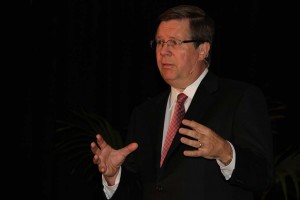It’s been the little engine that could, driving along an economy long struggling to avert a double-dip recession. And now, amidst growing signs that the U.S. economy is clearly on the mend, industry leaders are increasingly confident the auto industry is heading in fast-forward towards some extremely good – though probably not record – years.
As manufacturers get set to report extremely strong numbers for October, Toyota’s top American executive, Jim Lentz said he expects to see 2012 end with sales of 14.3 million – about 1 million more than a year before and a roughly 40% increase from the depths of the recession.
“And the forecast ahead looks even better,” Lentz said as he opened his keynote remarks at the opening of the annual LA Auto Show. “Analysts expect we will reach 16 million in just a few short years.”
That optimism was clearly echoed by other industry leaders gathering for the first of two days of media previews. The Los Angeles show has been something of a bellwether for the industry – and the economy. During the depths of the recession there was a sharp cutback in the number of new products on display. Chrysler, then plunging into bankruptcy, went so far as to shut off the spotlights at its 2008 exhibit to save cash.
This year, that maker’s lights are back on – and it has more than a half-dozen new products to debut if one includes its Italian partner Fiat. In fact, there are expected to be around 50 new models introduced at the LA Convention Center during the media gathering, half of them making their global debuts, the others appearing for the first time in the U.S.
Another key product on display is the 2014 Ford Fiesta, the remake of the maker’s smallest North American offering. The Fiesta is one of a fast-growing number of small, so-called B- and C-segment models targeting both buyers on a budget and others who simply want to downsize to reduce their fuel bills.
That market segment has grown from about 13% of overall U.S. car sales to 24% since 2004, notes Jim Farley, Ford’s global marketing chief.
Significantly, buyers don’t necessarily have to sacrifice room and performance to boost mileage, industry executives stress – pointing to the mix of new hybrids, plug-ins, battery cars and advanced conventional gasoline-powered vehicles. New technologies, such as Direct Injection and turbocharging are accomplishing what once seemed impossible: boosting performance as well as mileage.
The new Porsche Cayman sports coupe, which debuted Wednesday, delivers an extra 10 horsepower, for example, and about 15% better fuel economy.
Whether talking about entry-level econoboxes or luxury cars like the Porsche Cayman, “Mileage is top of mind” for just about all buyers, asserted Mark Fields, who will officially become the maker’s new Chief Operating Officer this week.
And the significant improvements in mileage are luring buyers back to showrooms, industry officials uniformly agreed. But there are other factors driving a demand surge. Auto loan interest rates are at or near historical lows, for one thing. Then there’s the issue of pent-up demand.
Auto sales have fallen at least 10 million below the trendline since the start of the recession and several recent studies show that this means the current U.S. fleet is older than ever, the majority of vehicles now in service for around a decade – and about 20% at least 16 years old.
The recession pushed many buyer groups out of the market, especially young motorists who have suffered a higher unemployment rate – and who may have been struggling to pay off hefty student loans. But in recent months, noted Toyota’s Lentz, “Younger buyers have returned to the market at a faster rate than any other segment.”
The revival of the youth market is clearly helping drive the current demand surge. Ironically, so is the rebuilding effort in the wake of Superstorm Sandy. By various estimates, the disaster may have ultimately cost the loss of 100,000 or more vehicles, many of which will be replaced by new products. According to Ford’s Fields, the industry is already seeing a sharp rise in sales in the greater New York area, where storm damage was most severe.
As a result, the Ford COO said he “wouldn’t be surprised” if November’s final figures came in at an annualized rate of around 15 million or more, which would be the industry’s best pace in nearly a decade.
There are some potential pitfalls. As the economy recovers, there are signs that fuel prices could once again spike. A modest upturn might actually increase demand for high-mileage models, though a major spike like the one seen last spring could choke off the U.S. recover, observers warn.
So might a failure by Congress and the White House to avert the so-called fiscal cliff, the need to work out new policies on taxing and spending. Ford Chairman Bill Ford recently warned this could also choke off a recovery, though a study by the University of Michigan was less worried about the impact on the auto industry.
Barring such setbacks, “We would expect the market to improve,” Fields concluded.
That’s particularly good news even though few expect to see peak sales during the current cycle reach the 17 million-plus numbers seen early in the new millennium. During the recession, most makers – and especially the struggling Detroit Big Three – took unprecedented steps to trim operating costs so even without reaching new sales records industry profitability could run substantially beyond anything ever seen in past auto sales boom years.

